Precipitation and Moisture Transport of the 2021 Shimokita Heavy Precipitation: A Transformed Extratropical Cyclone from Typhoon#9
Abstract
1. Introduction
2. Data and Methods
2.1. Precipitation Data
2.2. Atmospheric Data
2.3. TC Precipitation Composites
3. Results and Discussion
3.1. Precipitation Distribution and Time Series
3.2. Composited TC/EC Precipitation
3.3. Large-Scale Moisture Transport and TC/EC Precipitation
3.4. Vertical Distribution of Equivalent Potential Temperature and Moisture Transport
4. Conclusions
- Using additional rain gauges from Aomori Prefecture and MLIT, in addition to JMA’s AMeDAS, we successfully represented the heavy precipitation pattern and its time series over the landslide region.
- In most locations where the landslide disaster occurred, there were two precipitation peaks: at 9 UTC (Term 1: 0–15 UTC) and 18 UTC (Term 2: 15 UTC (9 August)—6 UTC (10 August)) on 9 August. The total precipitation over Shimokita Peninsula was greater in Term 2 than in Term 1.
- A common feature of the two terms was strong wind shear from the lower troposphere to the upper troposphere, with easterly winds in the lower troposphere below 900 hPa and warm moist air with a high equivalent potential temperature from the southeast flowing into the target area at approximately 850–700 hPa, and from the south flowing into the heavy rainfall area in the upper troposphere from 700 hPa.
- A strong gradient of equivalent potential temperature (especially for Term 2) and a northerly component with a lower troposphere and moisture convergence indicate the existence of the stationary front shown in the weather chart.
- During Term 1, moisture convergence was found over the Tsugaru Straits at approximately 800 hPa, while Term 2 did not show such a maximum.
- The large-scale moisture transport/convergence clarified that the heavy precipitation zone and strong moisture convergence that caused the Shimokita event were associated with the stationary front of EC9. The precipitation distribution, which has a precipitation peak northeast of the EC center, is a typical typhoon-turned-EC precipitation distribution.
Supplementary Materials
Author Contributions
Funding
Institutional Review Board Statement
Informed Consent Statement
Data Availability Statement
Acknowledgments
Conflicts of Interest
References
- Aomori Local Meteorological Office. Heavy Rain by a Low-Pressure Transformed from Typhoon#9 (9–10 August, 2021), Report of Disaster Meteorology in Aomori Prefecture. 25p. Available online: https://www.jma-net.go.jp/aomori/obs-fcst/disaster.html (accessed on 30 March 2023). (In Japanese).
- Kon, T.; Tsou, C.Y.; Koi, T.; Yamamoto, Y.; Koiwa, N.; Noda, R.; Irasawa, M.; Kato, K.; Tsushima, H.; Mori, H.; et al. Landslide hazards induced by heavy rainfall on August 2021 in the northern part of the Shimokita Peninsula, Aomori Prefecture. J. Jpn. Soc. Eros. Control Eng. 2022, 74, 41–51. (In Japanese) [Google Scholar]
- Kamahori, H. Mean features of tropical cyclone precipitation from TRMM/3B42. SOLA 2012, 8, 17–20. [Google Scholar] [CrossRef][Green Version]
- Lonfat, M.; Marks, F.D.; Chen, S.S. Precipitation distribution in tropical cyclones using the tropical rainfall measuring mission (TRMM) microwave imager: A global perspective. Mon. Weather Rev. 2004, 132, 1645–1660. [Google Scholar] [CrossRef]
- Shimazu, Y. Classification of precipitation systems in mature and early weakening stages of typhoons around Japan. J. Meteor. Soc. Jpn. 1998, 76, 437–445. [Google Scholar] [CrossRef][Green Version]
- Atallah, E.H.; Bosart, L.F.; Aiyyer, A.R. Precipitation distribution associated with landfalling tropical cyclones over the eastern United States. Mon. Weather Rev. 2007, 135, 2185–2206. [Google Scholar] [CrossRef]
- Nayak, S.; Takemi, T. Typhoon-induced precipitation characterization over northern Japan: A case study for typhoons in 2016. Prog. Earth Planet. Sci. 2020, 7, 39. [Google Scholar] [CrossRef]
- Kamahori, H.; Arakawa, O. Tropical cyclone induced precipitation over Japan using observational data. SOLA 2018, 14, 165–169. [Google Scholar] [CrossRef]
- Jones, S.; Harr, P.A.; Abraham, J.; Bosart, L.F.; Bowyer, P.J.; Evans, J.L.; Hanley, D.E.; Hanstrum, B.N.; Hart, R.E.; Lalaurette, F.; et al. The extratropical transition of tropical cyclones: Forecast challenges, current understanding, and future directions. Weather Forecast. 2003, 18, 1052–1092. [Google Scholar] [CrossRef]
- Kitabatake, N. Extratropical transition of tropical cyclones in the western North Pacific: Their frontal evolution. Mon. Weather Rev. 2008, 136, 2066–2090. [Google Scholar] [CrossRef]
- Kitabatake, N. Taifu no Ontaiteikiatsuka (Extratropical Transition of Tropical Cyclones); Fudeyasu, H., Nakazawa, T., Eds.; Kisyo kenkyu note (Meteorological research note); Japan Meteorological Society: Tokyo, Japan, 2013; Volume 226, pp. 127–148. (In Japanese)
- Ishitori, K.; Terauchi, S.; Yamaguchi, J.; Nerai, J. Shimokita heavy rainfall during 9–10 August—NHM experiment. In Proceedings of the Meteorological Research Meeting of the Tohoku Branch of the Japan Meteorological Society, 2021, Sendai, Japen, 13 December 2021; pp. 11–12. Available online: https://www.metsoc.jp/tohoku/workshop/abstract_2021.pdf (accessed on 30 March 2023).
- Yatagai, A.; Minami, K.; Masuda, M.; Sueto, N. Development of intensive APHRODITE hourly precipitation data for assessment of the moisture transport that caused heavy precipitation events. SOLA 2019, 15A, 43–48. [Google Scholar] [CrossRef]
- Kamiguchi, K.; Arakawa, O.; Kitoh, A.; Yatagai, A.; Hamada, A.; Yasutomi, N. Development of APHRO_JP, the first Japanese high-resolution daily precipitation product for more than 100 years. Hydrol. Res. Lett. 2010, 4, 60–64. [Google Scholar] [CrossRef]
- Japan Meteorological Agency. Table of location of the Typhoon#9 LUPIT (2109). 2021. Available online: https://www.data.jma.go.jp/yoho/data/typhoon/T2109.pdf (accessed on 9 December 2023).
- World Meteorological Organization. Global Guide to Tropical Cyclone Forecasting, WMO-1194; World Meteorological Organization: Geneva, Switzerland, 2017; 399p. [Google Scholar]
- Hersbach, H.; Bell, B.; Berrisford, P.; Hirahara, S.; Horányi, A.; Muñoz-Sabater, J.; Nicolas, J.; Peubey, C.; Radu, R.; Schepers, D.; et al. The ERA5 global reanalysis. Q. J. R. Meteor. Soc. 2020, 146, 1999–2049. [Google Scholar] [CrossRef]
- Yatagai, A.; Sakashita, Y.; Shirakawa, A. Precipitation distribution associated with the tropical cyclones over the Northern Pacific. In Proceedings of the Meteorological Research Meeting of the Tohoku Branch of the Japan Meteorological Society, 2020, Sendai, Japen, 7 December 2020; pp. 21–22. Available online: https://www.metsoc.jp/tohoku/workshop/abstract_2020.pdf (accessed on 30 March 2023).
- Atallah, E.H.; Bosart, L.F. The extratropical transition and precipitation distribution of Hurricane Floyd (1999). Mon. Weather Rev. 2003, 131, 1063–1081. [Google Scholar] [CrossRef]
- Kitabatake, N. Extratropical transition of Typhoon Tokage (0423) and associated heavy rainfall on the left side of its track over western Japan. Pap. Meteorol. Geophys. 2008, 59, 97–114. [Google Scholar] [CrossRef][Green Version]


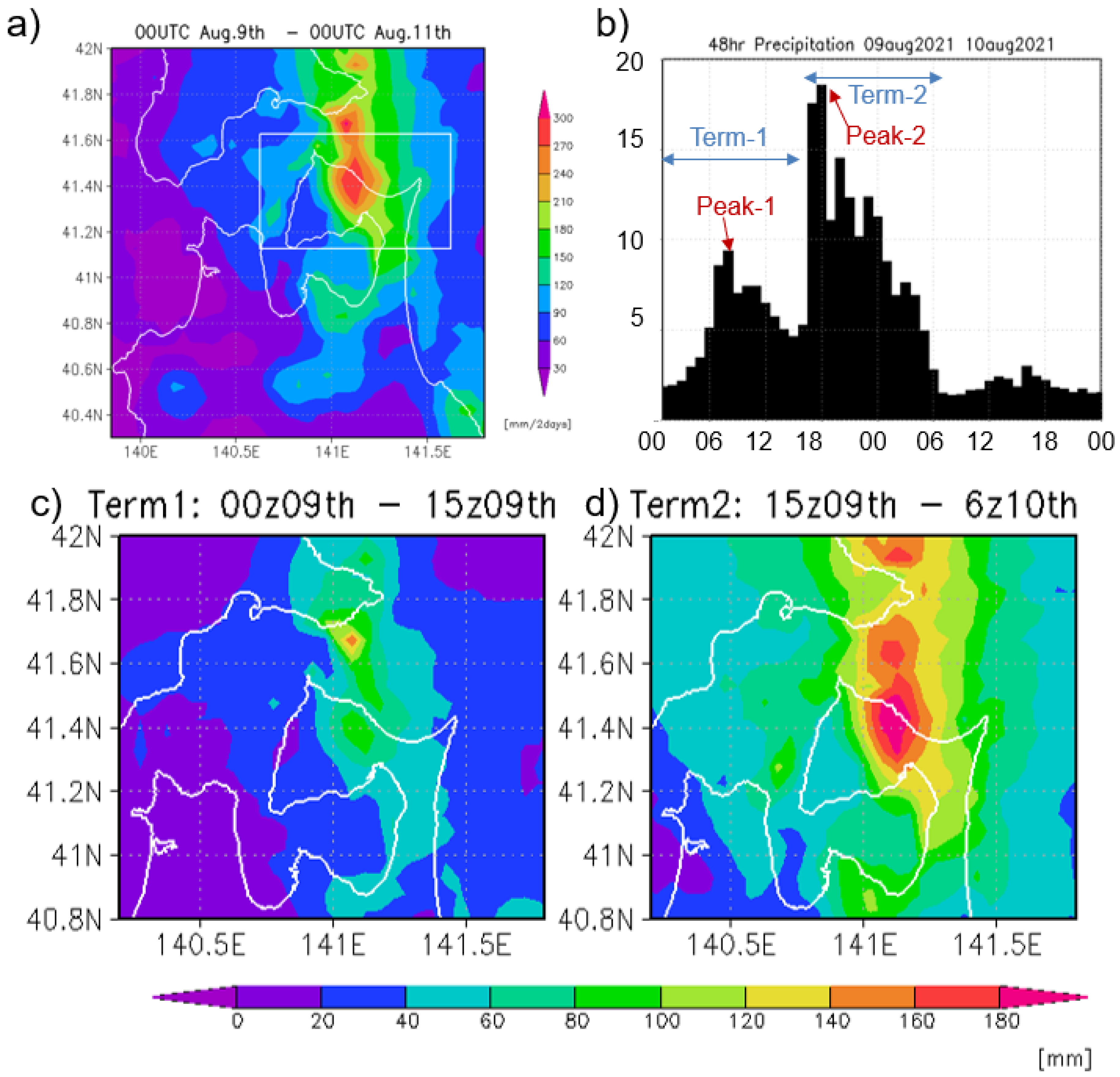
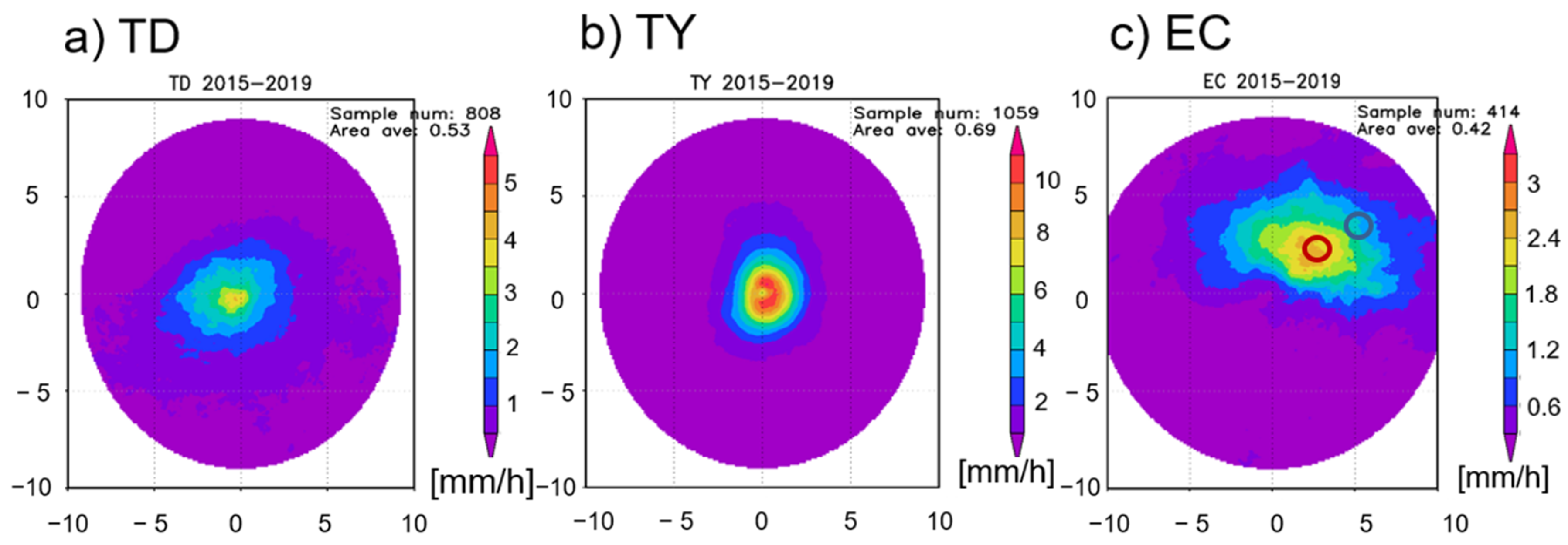

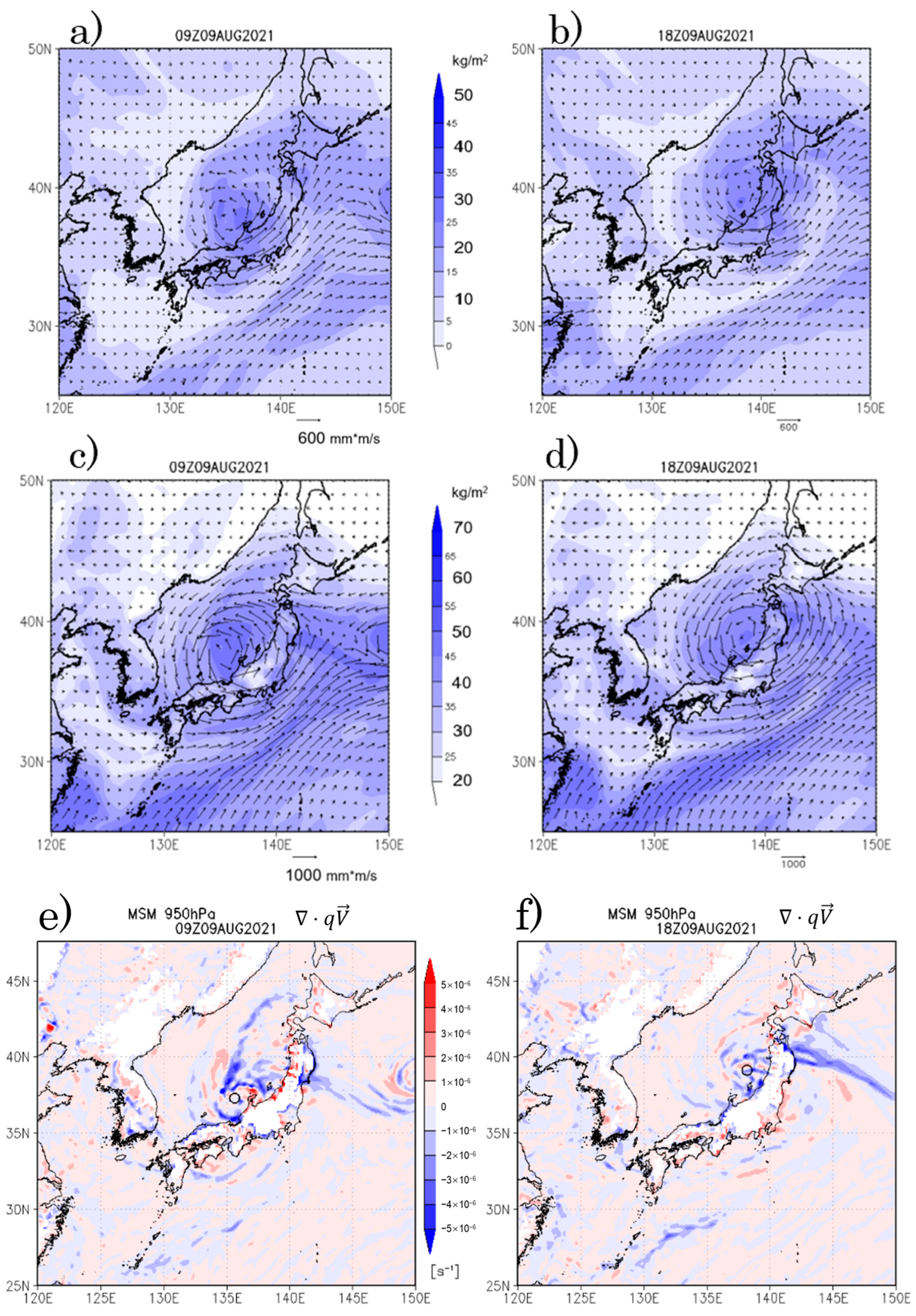
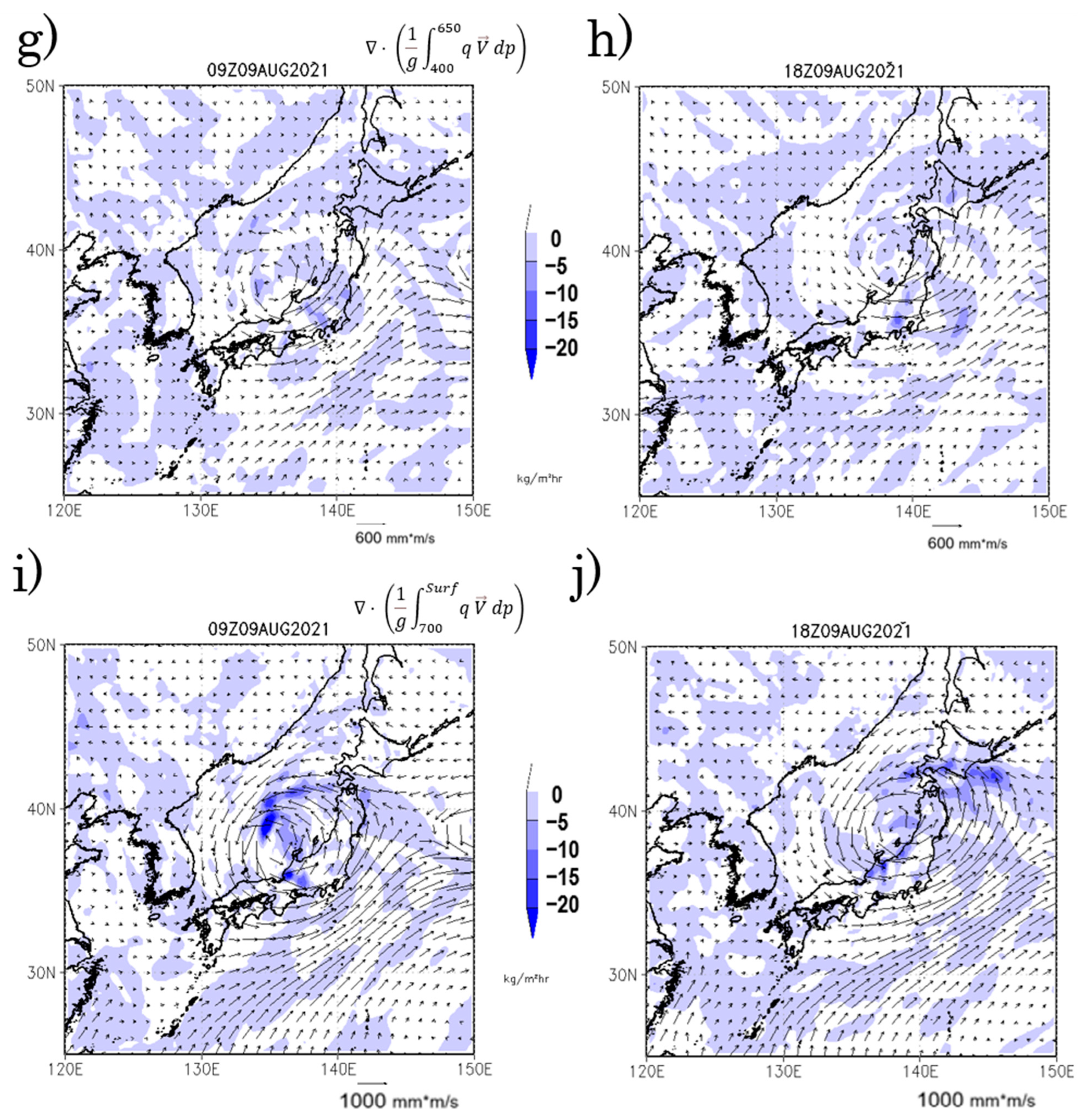
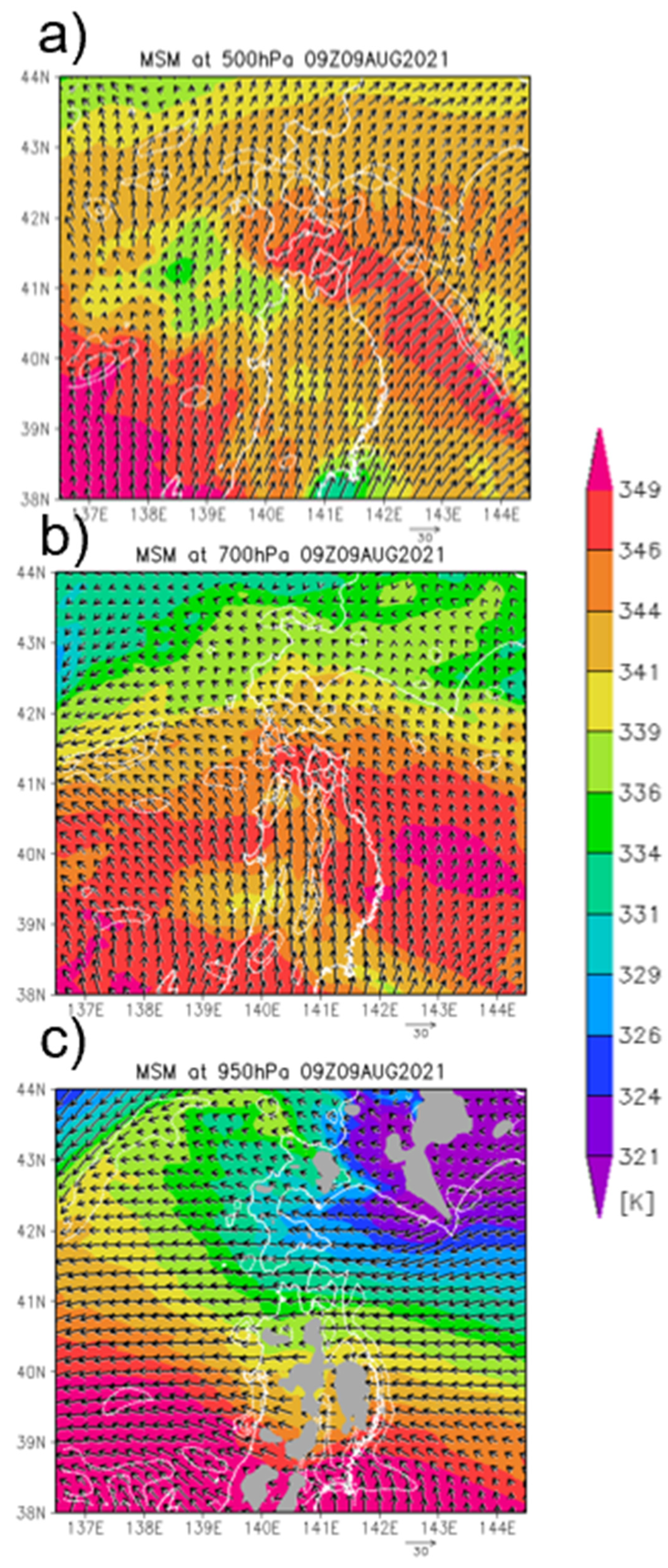

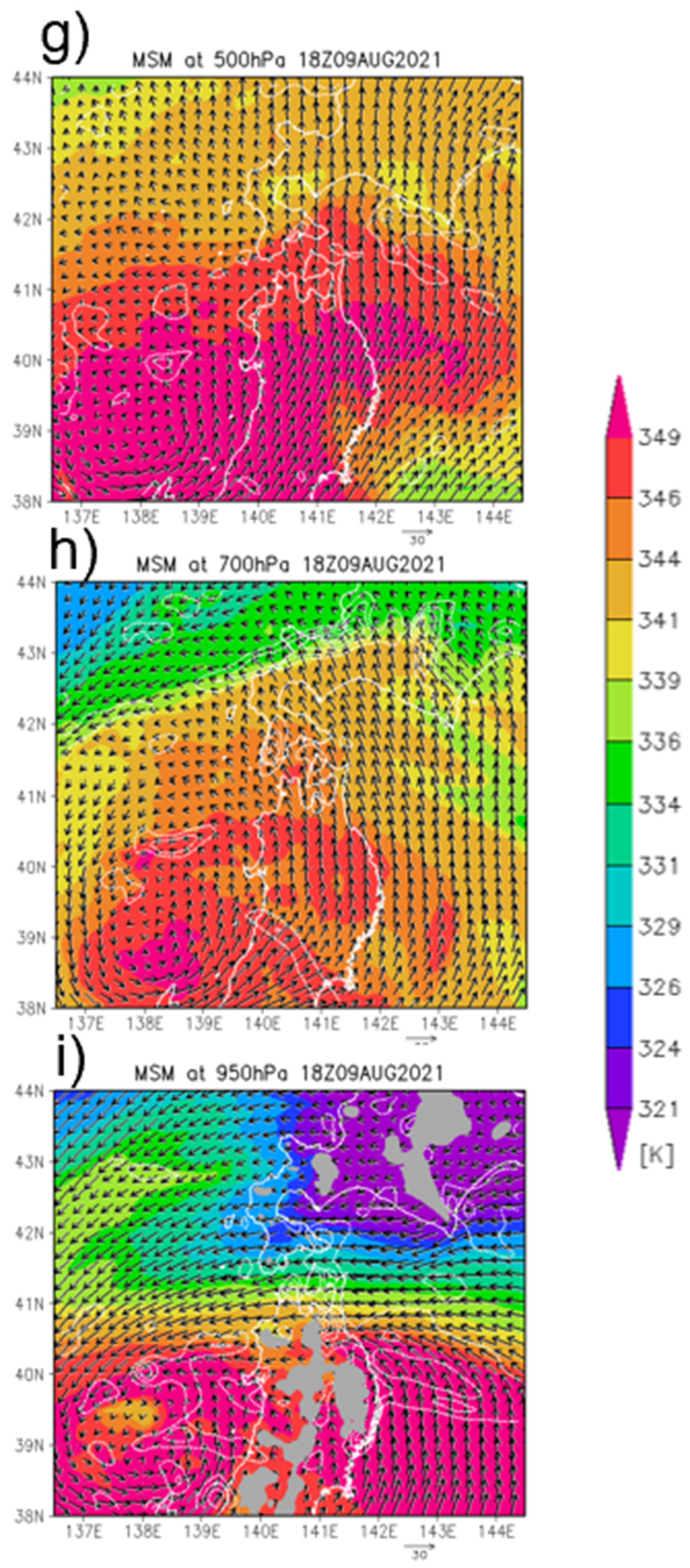

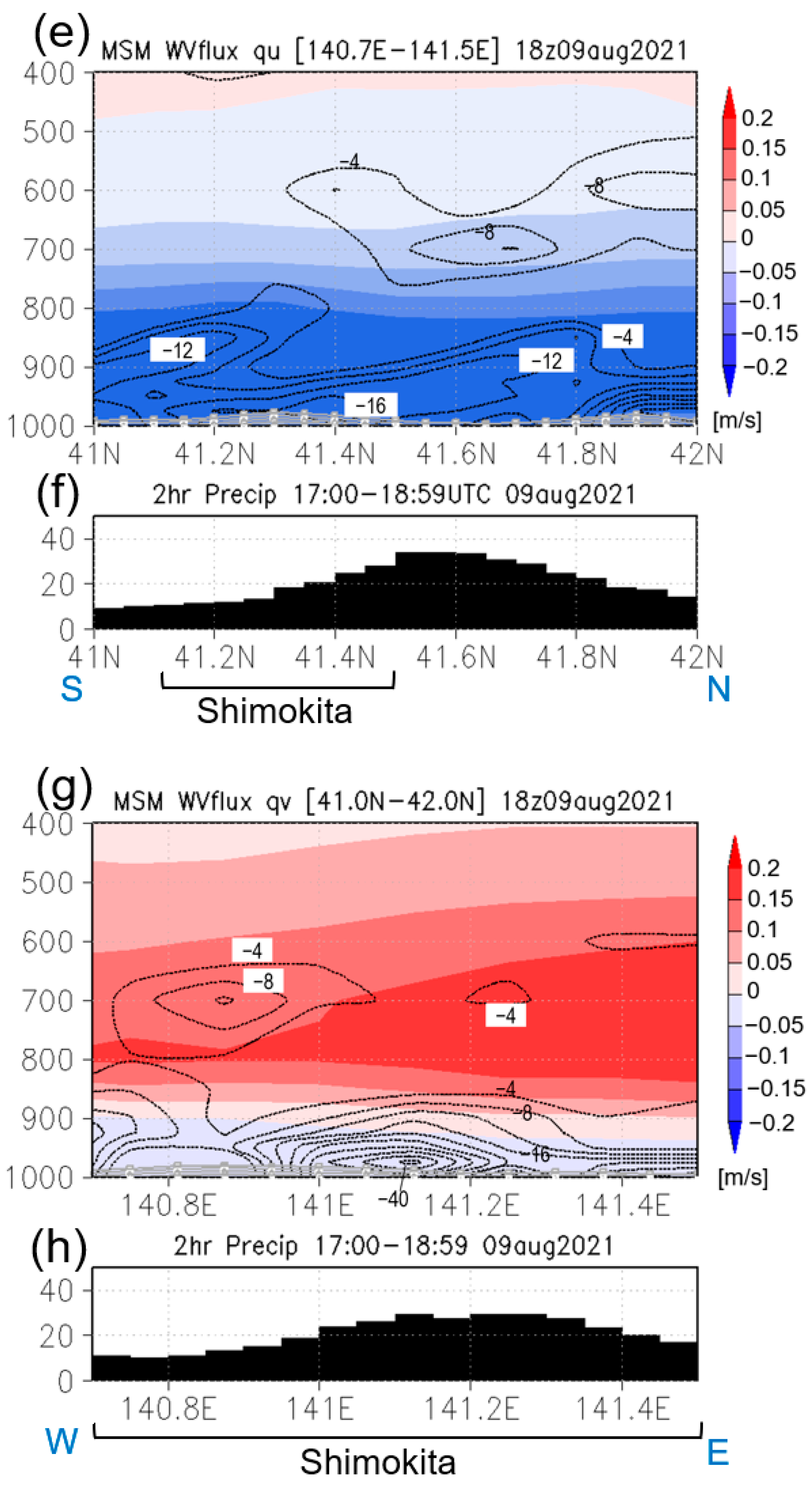
Disclaimer/Publisher’s Note: The statements, opinions and data contained in all publications are solely those of the individual author(s) and contributor(s) and not of MDPI and/or the editor(s). MDPI and/or the editor(s) disclaim responsibility for any injury to people or property resulting from any ideas, methods, instructions or products referred to in the content. |
© 2024 by the authors. Licensee MDPI, Basel, Switzerland. This article is an open access article distributed under the terms and conditions of the Creative Commons Attribution (CC BY) license (https://creativecommons.org/licenses/by/4.0/).
Share and Cite
Yatagai, A.; Saruta, S. Precipitation and Moisture Transport of the 2021 Shimokita Heavy Precipitation: A Transformed Extratropical Cyclone from Typhoon#9. Atmosphere 2024, 15, 94. https://doi.org/10.3390/atmos15010094
Yatagai A, Saruta S. Precipitation and Moisture Transport of the 2021 Shimokita Heavy Precipitation: A Transformed Extratropical Cyclone from Typhoon#9. Atmosphere. 2024; 15(1):94. https://doi.org/10.3390/atmos15010094
Chicago/Turabian StyleYatagai, Akiyo, and Shogo Saruta. 2024. "Precipitation and Moisture Transport of the 2021 Shimokita Heavy Precipitation: A Transformed Extratropical Cyclone from Typhoon#9" Atmosphere 15, no. 1: 94. https://doi.org/10.3390/atmos15010094
APA StyleYatagai, A., & Saruta, S. (2024). Precipitation and Moisture Transport of the 2021 Shimokita Heavy Precipitation: A Transformed Extratropical Cyclone from Typhoon#9. Atmosphere, 15(1), 94. https://doi.org/10.3390/atmos15010094





